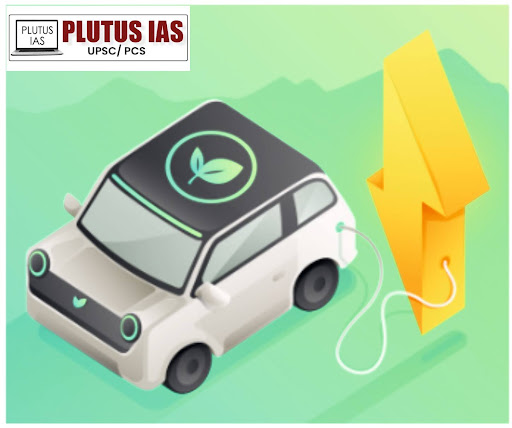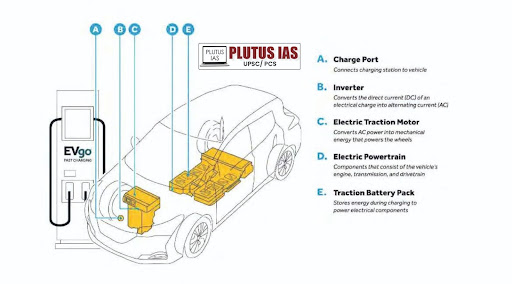06 Dec Electric vehicle (EV) technology: Greening the Transportation.
This article covers “Daily Current Affairs” and topic details of Electric vehicle (EV) technology: Greening the Transportation.
Syllabus mapping:
GS-3: Science and Technology: EV technology.
For Prelims:
What is the EV technology, EV technology mechanism of action. Greening technologies and the FAME INDIA initiative
For Mains:
What are the advantages of EV technology and its challenges making it a feasible technology? ways and policies to address EV Technology.
Why in the News?
India is experiencing a rapid rise in the adoption of electric vehicles (EVs) as part of its efforts to reduce air pollution, lower carbon emissions, and decrease dependence on fossil fuels. Recently, the Indian government has intensified its push for EVs through initiatives like the FAME India Scheme and the Production Linked Incentive (PLI) Scheme, offering financial incentives for manufacturers and consumers. Advancements in EV technology, such as regenerative braking, battery-swapping policies, and vehicle-to-grid integration, further support this drive.

Electric vehicle (EV) technology
Electric vehicle (EV) technology refers to the use of electricity to power vehicles, aiming to reduce the environmental impact of transportation and decrease reliance on fossil fuels.
Types of Electric Vehicles:
1. Battery Electric Vehicles (BEVs): Also called All-Electric Vehicles (AEVs), BEVs are powered solely by electric energy stored in lithium-ion batteries. They require plugging into a charging station to recharge the battery, and they produce no tailpipe emissions.
2. Plug-in Hybrid Electric Vehicles (PHEVs): These vehicles have both an electric motor and an internal combustion engine. They can be recharged via an external power source or by using the internal engine and generator to charge the battery, offering flexibility for long-distance travel.
3. Hybrid Electric Vehicles (HEVs): HEVs combine an internal combustion engine with an electric motor. The motor assists with driving the vehicle, but the battery is not typically plugged in for recharging. Instead, it charges via regenerative braking or the engine itself.
Working with Electric Cars:

Government Policies and Schemes:
1. FAME India Scheme (Faster Adoption and Manufacturing of Hybrid and Electric Vehicles): Launched in 2015, this scheme provides subsidies for the purchase of electric vehicles and encourages the manufacturing of EVs and hybrid vehicles. It aims to make EVs more affordable and increase their adoption across the country.
2. Production Linked Incentive (PLI) Scheme: This scheme offers financial incentives to manufacturers who meet specific production targets for electric vehicles and related components. It aims to boost domestic manufacturing and reduce dependence on imports.
3. Battery Swapping Policy: This policy addresses one of the main challenges in EV adoption—charging times. It promotes battery swapping stations where drained batteries can be quickly replaced with fully charged ones, improving the convenience and efficiency of EVs.
4. Model Building Bye-laws (MBBL), 2016: The MBBL mandates that residential and commercial buildings allocate 20% of their parking space for EV charging facilities. This ensures the availability of charging infrastructure as the number of EVs increases.
5. Charging Infrastructure Incentives: The government provides incentives such as land allocation and tax benefits to encourage public-private partnerships (PPPs) in developing the necessary charging infrastructure across the country. This will help create a widespread, accessible network for EV users.
6. New Electric Vehicle Policy 2024: The 2024 policy focuses on stimulating innovation in EV technology, supporting domestic manufacturing, reducing crude oil imports, mitigating air pollution, and contributing to India’s climate goals. This comprehensive policy is designed to accelerate the adoption of EVs while achieving broader environmental and economic objectives.
Benefits of Electric Vehicles (EVs):
1. Lower Running Costs: EVs are much cheaper to operate compared to traditional petrol or diesel vehicles. They use electricity, which is more cost-effective, especially when combined with renewable energy sources like solar panels. This significantly reduces the cost of daily commutes and long-distance travel.
2. Low Maintenance Costs: With fewer moving parts than conventional vehicles, EVs require less maintenance, resulting in lower servicing costs. The absence of components like an internal combustion engine or exhaust system reduces wear and tear, making EVs a cost-effective option in the long run.
3. Zero Tailpipe Emissions: One of the most significant advantages of EVs is their zero tailpipe emissions. This helps reduce carbon footprints, combat climate change, and improve air quality, especially in urban areas.
4. Tax and Financial Benefits: EVs often benefit from lower registration fees, road taxes, and government incentives. Policies vary by state, but many offer financial benefits that make owning an EV more affordable.
5. Environmental Impact: Petrol and diesel vehicles contribute heavily to pollution, affecting public health and the environment. EVs offer a cleaner alternative with much lower emissions, both in terms of tailpipe emissions and energy consumption. They are more efficient and use up to 60% of the grid’s electrical energy for propulsion.
6. Convenience of Charging at Home: EV owners can conveniently charge their vehicles at home, eliminating the need to visit fuel stations. Charging at home before heading out saves time and reduces the stress of refueling, especially during peak hours.
7. Quiet Operation and No Noise Pollution: EVs are incredibly quiet, as they don’t have traditional engines. This not only provides a peaceful driving experience but also helps reduce noise pollution in cities. Some EVs have added artificial sounds to ensure safety for pedestrians, but they remain much quieter than conventional vehicles.
8. Easy to Drive: EVs offer a simpler driving experience as they don’t have gears. Drivers only need to accelerate, brake, and steer, making them user-friendly for all age groups and driving experience levels.
9. Reduced Dependence on Fossil Fuels: The use of petrol and diesel is harmful to the environment and contributes to the depletion of fossil fuels. EVs are a sustainable solution, reducing dependency on non-renewable energy sources and aiding in the transition to a greener future.
Challenges of the EV Industry:
High Battery Costs: EV batteries are one of the most expensive components, making electric vehicles significantly pricier than traditional cars. While manufacturers are investing in affordable battery technologies, the high cost remains a barrier for many buyers.
Limited Charging Infrastructure: The lack of sufficient charging stations, particularly in rural and suburban areas, discourages EV adoption. Many charging attempts fail due to issues such as damaged chargers, congestion, or difficulty locating stations.
Range Anxiety: Consumers often worry about the limited driving range of EVs and their ability to handle long-distance travel. Although modern EVs achieve ranges of over 300 miles per charge, this concern persists among potential buyers.
Supply Chain Challenges: The production of EVs depends on critical materials like lithium, cobalt, and nickel, which face supply chain disruptions and rising costs. Geopolitical tensions and mining challenges further complicate the availability of these essential resources.
Gender Interest Gap: Surveys show men are more likely than women to prefer EVs, a disparity influenced by marketing, practicality, and affordability concerns. Targeted strategies addressing the needs and preferences of women drivers could help bridge this gap.
Recycling and Disposal: Recycling EV batteries remains a challenge, with inefficiencies threatening the sustainability of electric vehicles. Manufacturers are developing recycling programs to repurpose and efficiently recycle used batteries.
High Initial Costs: Despite offering long-term savings, EVs have higher upfront costs than conventional vehicles, deterring budget-conscious buyers. Lowering production costs and passing savings to customers is crucial to increase accessibility.
Grid Capacity Strain: Many power grids are not equipped to handle the growing demand for EV charging, leading to strain and congestion. Expanding grid capacity and integrating renewable energy sources are essential to support future EV growth.
Resistance from Traditional Automakers: Some established car manufacturers are slow to transition fully to EV production, focusing instead on hybrids or fossil-fuel vehicles. This resistance slows innovation and affects consumer confidence in the EV market.
Way Forward to Overcome EV Adoption Challenges in India
1. Government Incentives: The Indian government can continue to offer subsidies and incentives under the FAME India Scheme and additional tax rebates to reduce the upfront costs for consumers.
2. R&D Investment: Increasing investments in battery research and development (R&D) to develop cost-effective, high-performance battery technologies will be crucial. Manufacturers like Tata and Mahindra are already focusing on producing lithium-ion batteries locally to reduce dependency on imports and cut costs.
3. Battery Leasing Models: Companies like Ola Electric are exploring battery leasing models, where consumers can pay only for battery usage, reducing the initial vehicle cost. Expanding these models will make EVs more affordable.
4. Public-Private Partnerships (PPPs): The government should expand public-private partnerships to develop a robust network of charging stations across the country. State and municipal bodies can also incentivize the installation of charging points in commercial spaces, residential buildings, and along highways.
5. Fast Charging Technology: Expanding the availability of fast chargers and supporting companies working on ultra-fast charging technologies will significantly reduce charging time and make EVs more convenient for long-distance travel.
6. Home Charging Solutions: Encouraging individuals to install home chargers and offering incentives for installing at-home charging stations, particularly in urban areas, can reduce the reliance on public charging infrastructure.
7. Incentivizing Transition: The government can provide incentives for automakers to ramp up EV production and phase out fossil-fuel vehicles. Policies that mandate a certain percentage of electric vehicles in the production line can force the industry to innovate and meet the demand for EVs.
8. Industry Collaboration: Collaboration between traditional automakers, EV manufacturers, and tech companies can foster innovation and speed up the transition to electric vehicles.
9. Grid Upgrades and Smart Grids: The government should invest in modernizing and expanding the electricity grid to handle the increased load. Implementing smart grids that can manage the charging patterns of EVs more efficiently will be essential.
10. Renewable Energy Integration: Integrating renewable energy sources, like solar and wind, into the grid will ensure that the energy used to charge EVs is sustainable. The government’s push for renewable energy capacity will play a crucial role in supporting the transition to EVs.
Conclusion:
In essence, electric cars are powered by the stored energy in their traction battery pack, which is converted by an inverter and used by the electric motor to move the vehicle. The charging process, energy storage, and power transfer mechanisms work seamlessly to deliver a smooth and efficient driving experience while reducing harmful emissions.
Download Plutus IAS Current Affairs Eng Med 6th Dec 2024
Prelims question:
Q. With reference to Electric Vehicle Technology, Consider the following statement:
1. The EV technology AC-DC current converter to run vehicle motor
2. The tailpipe emission from the EV vehicles is zero
3. The FAME India initiative is to promote EV use in India
How many of the above-given statements are correct?
A. Only one
B. Only two
C. All three
D. None
ANSWER: C
Main Question:
Q. “Despite the promising potential of electric vehicle (EV) technology for greener transportation, several challenges remain. Discuss the current loopholes in EV technology and suggest measures to address them for sustainable and widespread adoption of electric vehicles.”
(Answer 250 words)




No Comments